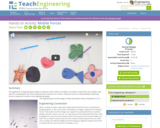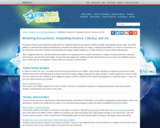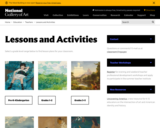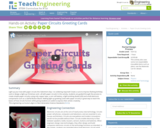
The Museum of Modern Art presents this classroom or group activity for making stencil portraits. Requires Adobe Reader. [PDF]
- Subject:
- Arts
- Material Type:
- Interactive
- Provider:
- The Museum of Modern Art (MoMA)
- Date Added:
- 10/03/2023

The Museum of Modern Art presents this classroom or group activity for making stencil portraits. Requires Adobe Reader. [PDF]

The application of engineering principles is explored in the creation of mobiles. As students create their own mobiles, they take into consideration the forces of gravity and convection air currents. They learn how an understanding of balancing forces is important in both art and engineering design.

This article describes a number of creative projects that incorporate art and literacy skills into a science unit on biomes and ecosystems.

Students watch biographical accounts of three artists of the West: Charlie Russell, George Catlin, and Evelyn Cameron then compare and contrast the focus and perspectives of each of the artists.

The University of North Carolina museum's site offers articles, videos, artwork, crafts, music, and histories of Native Americans.

A RagGonNon is textile art (quilt) created by Aminah-Brenda Lynn Robinson, displayed at The National Underground Railroad Freedom Center. She made it over 30 years and is constructed out of different rags and tells a story of her and her family's past. In

A great activity where students write their own mysteries-with a creative twist. Provides a list of resources, and adaptations. (To access this lesson plan, you must register with Crayola.com. Registration is free and takes only a few moments to complete.)

An illustrated article highlighting the science behind carbon and fossil fuels. Diagrams and graphs help with understanding.

Lesson plans and curriculum including https://www.nga.gov/education/teachers/lessons-activities/uncovering-america.html Uncovering America-What does it mean to be American?
Discover compelling stories of creativity, struggle, and resilience in this new set of resources for K–12 educators featuring works of art that reflect the richness and diversity of the people, places, and cultures of the United States. Encourage creative, critical, and historical thinking in your students as you examine works of art from the country’s creation to the present day.
Thematic modules contain:
Introductory essays
Downloadable high-resolution image sets featuring background information
Essential questions for students
Classroom activities
Selected additional resources
What’s your American story? Share with #AmericanStoriesNGA or send your stories to classroom@nga.gov
Unless otherwise expressly provided elsewhere on the National Gallery of Art’s website (“Site”), and in such instance only as specifically provided, the contents of this Site, including all images and text, are for personal, educational, non-commercial use only, and may not be reproduced in any form without the permission of the National Gallery of Art

Learn how to create a dreamcatcher, an item designed to catch bad dreams and let good dreams through. The dreamcatcher originated with the Ojibwe but has been adopted by other nations. Included are teaching tips and additional background information. [3:11]

From the site: "It was supposed to be a short-term research project. Instead, it became a lifetime of learning. Along the way, people learned to see gorillas in a whole new light. 'A Conversation with Koko' tells the remarkable story of Dr. Francine 'Penny' Patterson's nearly 30-year relationship with Koko, a western lowland gorilla she taught to communicate in sign language."

Learn about the art, the people, and the culture of the digital revolution with Off Book. This revolutionary program from PBS Digital Studios combines top-tier journalism with the underground, and often ignored, subject matter of today's modern digital age. With topics ranging from internet culture and graphic design, to the worlds of video games and coding, Off Book examines the changing world of contemporary art like it's never been seen before. This collection consists of 27 videos for grades 6-8 and 9-12.

Harvey Webster explores the art and features of the outside campus of the Cleveland Museum of Natural History. Worksheet available for all ages.

This passage from William Morey's 1901 textbook tells about Trajan, one of Rome's greatest rulers. Included is a chart showing all the Roman provinces and the dates they were acquired.

Explore top selections from the PBS Digital Studios library. This content is edgy and engaging, educational and thought - provoking - designed to grab your students' attention. Explore our collections curated towards design and innovation, social studies, and even popular culture, with many more subjects that highlight the cross-disciplinary, exciting topics that have made Digital Studios such a powerful classroom resource. This collection includes 92 videos.

Explore the crossroads of art, science, and pop culture with PBS Idea Channel. Hosted by Mike Rugnetta, the Idea Channel launched in 2012 and has since posted over 100 videos, with more added every Wednesday. The program has quickly grown to one of the most watched on the web, winning multiple Webby Awards and receiving praise for Mike's active engagement in the viewing community. Each video contains feedback and replies to previous work, keeping the program fresh and establishing a platform for discussion. Discover, share, and engage more with the Idea Channel community at the Youtube page here. This Collection includes: (55) Videos for Grades 6-8, 9-12.

PBS explores the world of India with an in-depth look into the Kushan Empire. Identifies the origins of the empire, the location of the empire, and the connection to the Silk Road. Describes the importance of art and literature to the empire, their connection to Buddhism, and their link to coinage. Identifies their greatest ruler, wars they were involved in and how coins have allowed modern historians to accurately depict the history of the Kushan Empire.

Video clip defines and illustrate the style of jewelry produced by the Mughals, a tradition that continues into the present. [1:50]

Discover the history of a favorite American past-time. Learn the art of creating your own masterpieces with a little bit of help.

Light up your love with paper circuits this Valentine’s Day—no soldering required! Create a sure-to-impress flashing birthday card or design a light-up Christmas card—all with paper circuits! In this activity, students are guided through the process to create simple paper circuitry using only copper tape, a coin cell battery, a light-emitting diode (LED) and small electronic components such as a LilyPad Button Board. Making light-up greeting cards with paper circuitry is great way to teach the basics of how circuits function while giving students an outlet to express their artistic creativity.